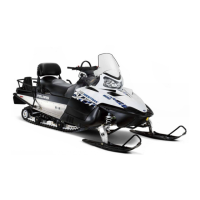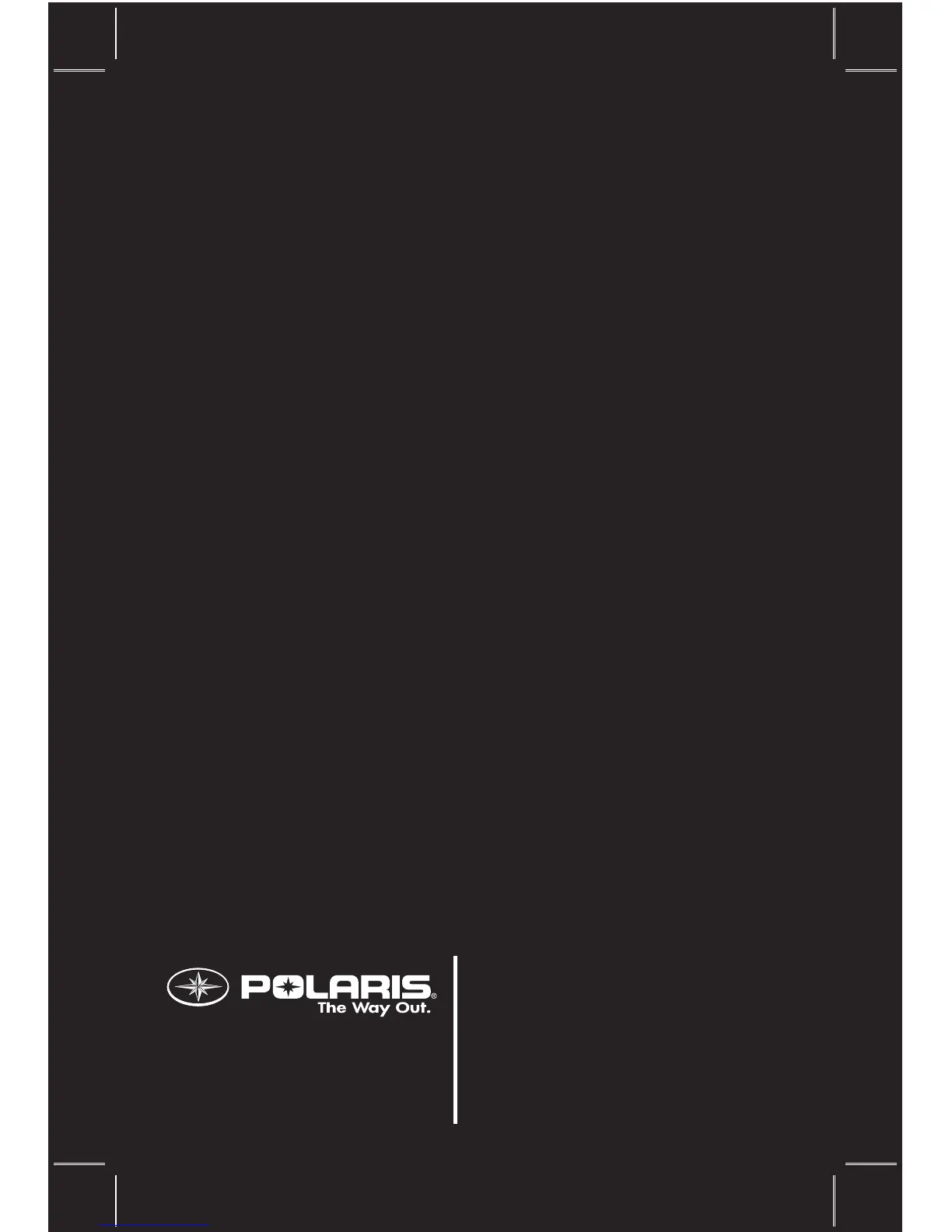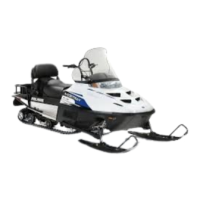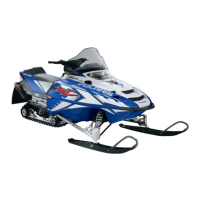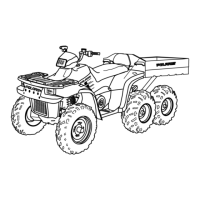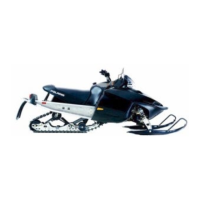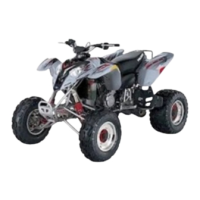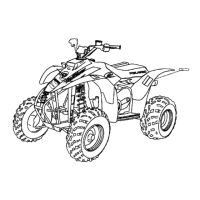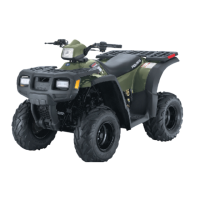SAFETY Page: 10 Stay Clear of Track Warns about entanglement hazards with the track and recommends dealer service.
Riding Position Explains the importance of proper rider posture for control and safety.
Riding Apparel Discusses the importance of helmets, eye protection, and appropriate clothing.
Cargo Overload Warns about the impact of excess weight on steering and passenger placement.
Disabled Operators Advises against operation by individuals with cognitive or physical disabilities.
Rider Capacity Details single-rider (1-Up) and two-rider (2-Up) configurations and responsibilities.
Excessive Speed Warns about the dangers of high speeds, especially at night or in poor visibility.
Driver Awareness Covers awareness of obstacles, road crossings, and ice conditions.
Avalanches Provides training and equipment advice for riding in mountainous terrain.
Driving on Slopes Provides guidance on climbing, crossing, and descending slopes safely.
Driving Downhill Details weight shifts and braking techniques for safe downhill riding.
Clutch Guard Explains the importance of the clutch guard for operator protection.
Drive Belt Advises against operating without the drive belt and mentions dealer servicing.
Intake Silencer Warns against removing the intake silencer/filter to prevent engine damage.
Clutches Recommends dealer servicing for clutches due to their complexity.
Maneuverability Explains how body weight affects control and how maneuverability varies.
Track/Seat Warning Warns about entanglement hazards with the track and falling from the seat back.
Reverse Warning Advises on safe reverse operation, including shifting and turning.
Operation Warning Lists critical warnings for reading the manual, speed, alcohol, and protective gear.
PRE-RIDE INSPECTIONS Page: 41 Pre-Ride Checklist A table listing items to inspect before each use with corresponding page numbers.
Throttle Lever Details how to check throttle lever function and return to idle.
Hydraulic Brakes Explains how to check brake lever travel and feel for proper function.
Steering System Guides on checking steering linkage for ice/snow build-up and lubrication.
Track Warns about damaged tracks and the use of traction products.
Hood Latches Stresses securing hood latches for safety and emission control.
Seat Latches Advises ensuring seat latches are secure before operation.
Recoil Rope Guides on inspecting the recoil rope for wear and dealer replacement.
Transmission Reminds to ensure the transmission is not in reverse before starting.
Engine Stop Switch Explains how to use the engine stop switch for emergencies and normal shutdown.
Lighting Advises checking headlights, taillights, and brake lights.
Operating Area Advises checking surroundings and bystanders before driving.
Ignition Switch Instructs to ensure the engine stops when the ignition switch is turned OFF.
OPERATION Page: 48 Engine Break-In Details the importance of proper engine break-in and initial fuel/oil mixture.
Track Warm-Up Explains the procedure for warming up the engine, drive train, and track.
Fuel Provides essential safety precautions for handling gasoline.
Oil Explains the function of the low oil indicator light and recommended actions.
Low Oil Level Guides on checking and filling the oil level to the proper mark.
Carburetion Discusses proper carburetor adjustment for performance and engine health.
Jetting Guidelines Explains how altitude and temperature affect jetting and the need for recalibration.
Throttle Lever Warns about improper throttle lever function and troubleshooting steps.
Towing Provides safety warnings and instructions for towing the snowmobile.
MAINTENANCE Page: 62 Lubrication Details lubrication points and intervals for suspension and steering components.
Rear Suspension Illustrates lubrication points for the rear suspension system.
Jackshaft Bearing Explains that the jackshaft bearing is greased for life and requires no additional lubrication.
Throttle Cable Details lubrication of the throttle cable and handlebars.
Choke and Cable Advises on lubricating choke slide and cables to prevent freezing.
Coupler Greasing Instructions for greasing couplers on the driveshaft and jackshaft.
Spark Plugs Discusses the importance of selecting the correct spark plug and potential issues.
Intake Filter Explains the intake filter's function and the need to reinstall it after cleaning.
Carburetor Guides on draining and inspecting carburetor bowl water/sediment traps.
Oil Filter Advises on changing the oil filter annually or every 1000 miles.
Exhaust System Details inspection of the exhaust system for wear or damage at 1000 miles.
Drive Chain Tension States that the WideTrak has an automatic chain tensioner requiring no maintenance.
Brakes Instructs on inspecting brake lever reserve and replacing brake pads when worn.
Brake Fluid Explains brake fluid properties, level check, and replacement recommendations.
Lights Details the procedure for adjusting the vertical aim of the headlight.
Clutch System General inspection of clutch sheaves for damage, wear, or belt residue.
Torque Stop Guides on checking and adjusting torque stop clearance.
Tool Kit Mentions the included tool kit for emergency and routine maintenance.
Fall Tune-Up Recommends a fall service tune-up with a Polaris dealer for maximum performance.
Track Warns about broken track rods and how to inspect the track for damage.
Track Lubrication Explains the need for snow cover for lubrication and warns against operation on ice.
Track Tension Details the procedure for measuring and adjusting track tension.
Track Alignment Guides on checking and adjusting track alignment for even wear.
Steering System Advises weekly inspection of steering fasteners and tightening as necessary.
Ski Alignment Warns about improper ski alignment and advises dealer correction.
Ski Skags Explains the function of skags and their replacement when worn.
Battery Advises on checking and maintaining battery fluid levels.
Battery Removal Provides safety warnings and steps for removing the battery.
Battery Storage Provides guidelines for storing the battery during off-season.
Daily Storage Advises on proper parking and securing the snowmobile after each ride.
Extended Storage Outlines preventive measures for off-season storage of the snowmobile.
Bearings Guides on greasing drive shaft clutch side bearing for corrosion prevention.
Battery Refers to page 95 for battery preparation and maintenance.
Track and Suspension Advises moderate track tension and supporting the snowmobile off the ground for storage.
